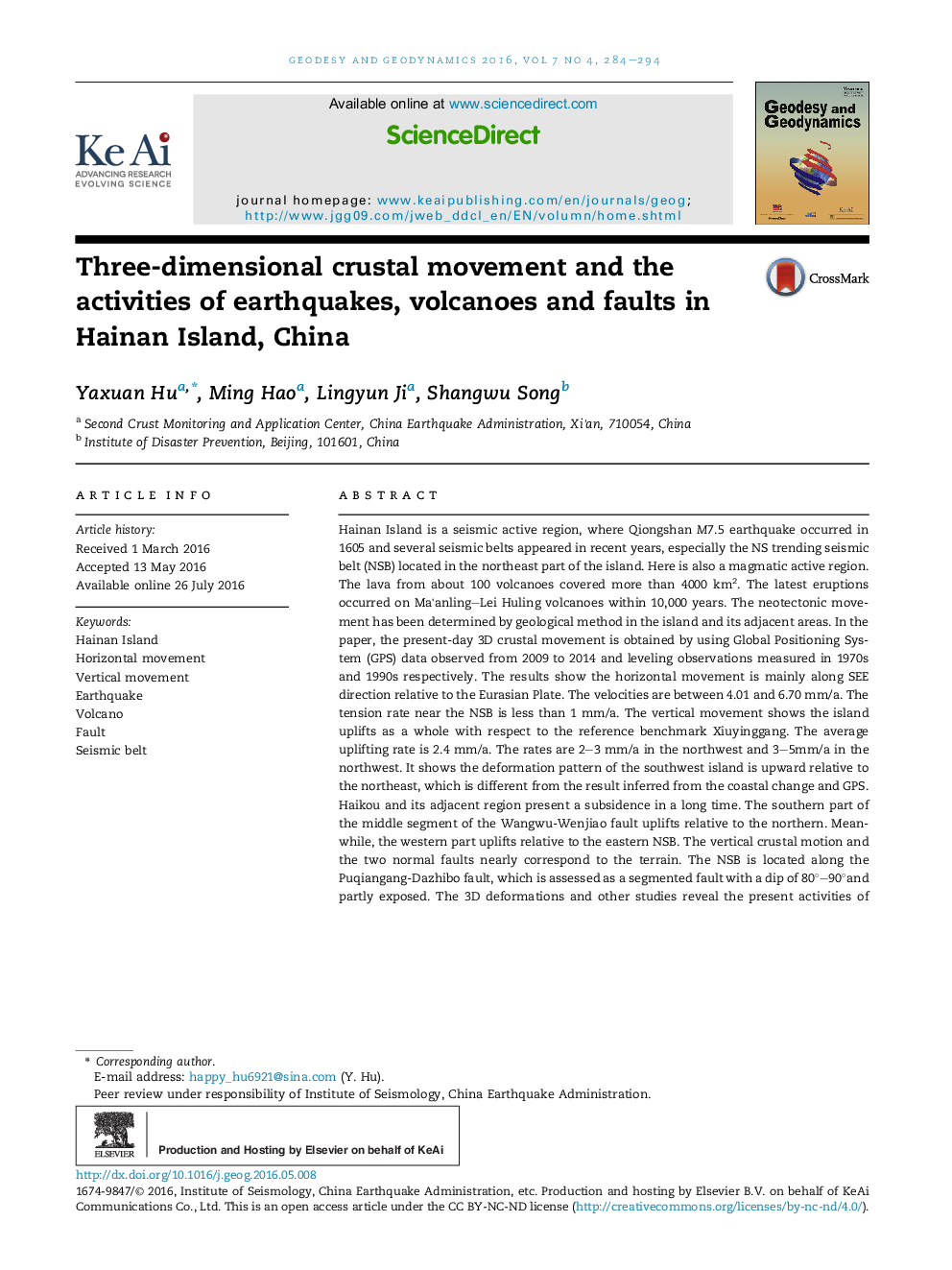| کد مقاله | کد نشریه | سال انتشار | مقاله انگلیسی | نسخه تمام متن |
|---|---|---|---|---|
| 4683496 | 1349314 | 2016 | 11 صفحه PDF | دانلود رایگان |
کلید واژه ها
1.مقدمه
شکل شماره 1: سرعت های GPS نسبت به اوراسیا در دروه های 1999تا 2013. جعبه قرمز کوچک منطقه مورد مطالعه را نشان می دهد.
شکل شماره 2: سرعت GPS نسبت به اوراسیا در طول 2009 تا 2014 (آبی).
2. حرکت افقی
جدول شماره 1: تغییر خط مبنا (dl) در چین و مناطق اطراف
3. حرکات عمودی
3-1 تغییر شکل عمودی به دست آمده توسط GPS و تسطیح
3.2نتایج GPS مشابه تغییرات ساحلی است (شکل 3 و بخش 3-2).
شکل شماره 4: نرخ تغییر شکل عمودی با بارهای خطا توسط تسطیح در سال های 1970 تا 1990 مشخص شده است (خطوط آبی). خط سبز ارتفاع را نشان می دهد.
شکل شماره 5: برخی از مسیرهای تسطیح مطالعات قبلی. HCJ, Haikou-Chengmai-Jiale; HT, Haikou-TunChang; HH, Haikou- Huangzhu; HW, Haikou-Wenchang; WL,Wengtian-Longfa; WH, Wenchang-Huangzhu . جعبه قرمز رنگ منطقه مورد مطالعه را نان می دهد.
شکل شماره 6a: تغییر شکل عمودی از جنوب به شمال برای سه بازه زمانی. تغییر شکل طی سال های 1974 تا 1982 و 1974 تا 1977 از مرجع هستند. B) تغییر شکل عمودی از غرب به شرق برای سه دوره زمانی. تغییر شکل طی سال های 1974 تا 1982 و 1974 تا 1977 از مرجع هستند.
3-2 تغییر شکل عمودی به دست آمده توسط تغییرات ساحلی
4. بحث و نتیجه گیری
4-1 فعالیت لرزه ای
4-2 فعالیت آتشفشان
4-3 فعالیت گسل
4-4 شبیه سازی تغییر شکل NSB
4-5 نتیجه
جدول 6: پارامترهای دایک یا گسل برای بهترین مدل ها
شکل شماره 7: نرخ تغییر شکل عمودی با تسطیح دقیق در طول NSB شناسایی شده است. خطوط شکسته گسل را نشان می دهند. فاصله ها بین نشانه ها و مرکز NSB هستند.
Hainan Island is a seismic active region, where Qiongshan M7.5 earthquake occurred in 1605 and several seismic belts appeared in recent years, especially the NS trending seismic belt (NSB) located in the northeast part of the island. Here is also a magmatic active region. The lava from about 100 volcanoes covered more than 4000 km2. The latest eruptions occurred on Ma'anling–Lei Huling volcanoes within 10,000 years. The neotectonic movement has been determined by geological method in the island and its adjacent areas. In the paper, the present-day 3D crustal movement is obtained by using Global Positioning System (GPS) data observed from 2009 to 2014 and leveling observations measured in 1970s and 1990s respectively. The results show the horizontal movement is mainly along SEE direction relative to the Eurasian Plate. The velocities are between 4.01 and 6.70 mm/a. The tension rate near the NSB is less than 1 mm/a. The vertical movement shows the island uplifts as a whole with respect to the reference benchmark Xiuyinggang. The average uplifting rate is 2.4 mm/a. The rates are 2–3 mm/a in the northwest and 3–5mm/a in the northwest. It shows the deformation pattern of the southwest island is upward relative to the northeast, which is different from the result inferred from the coastal change and GPS. Haikou and its adjacent region present a subsidence in a long time. The southern part of the middle segment of the Wangwu-Wenjiao fault uplifts relative to the northern. Meanwhile, the western part uplifts relative to the eastern NSB. The vertical crustal motion and the two normal faults nearly correspond to the terrain. The NSB is located along the Puqiangang-Dazhibo fault, which is assessed as a segmented fault with a dip of 80°–90°and partly exposed. The 3D deformations and other studies reveal the present activities of earthquakes, volcanoes and the faults. The small earthquakes will still occur in the NS belt and the volcanoes are not active now.
Journal: Geodesy and Geodynamics - Volume 7, Issue 4, July 2016, Pages 284–294
